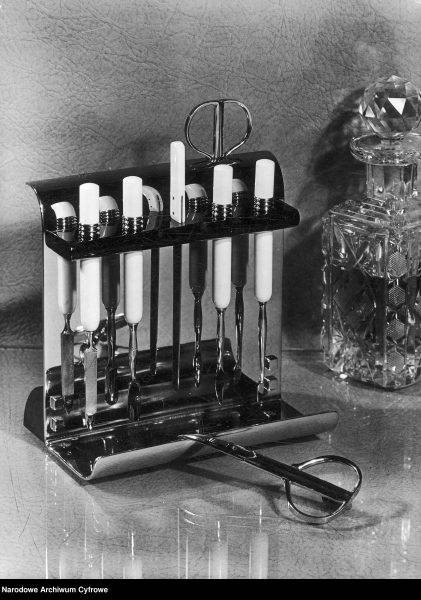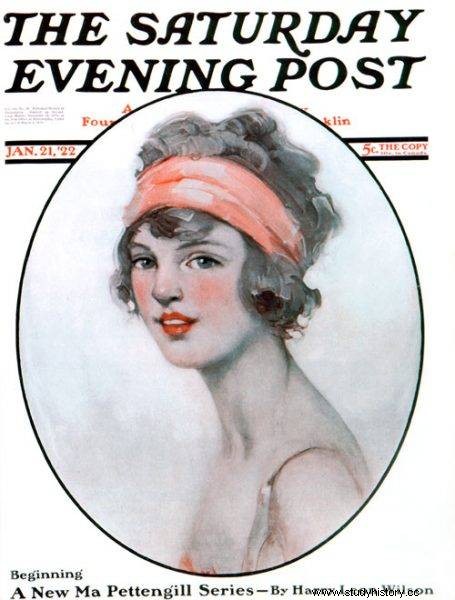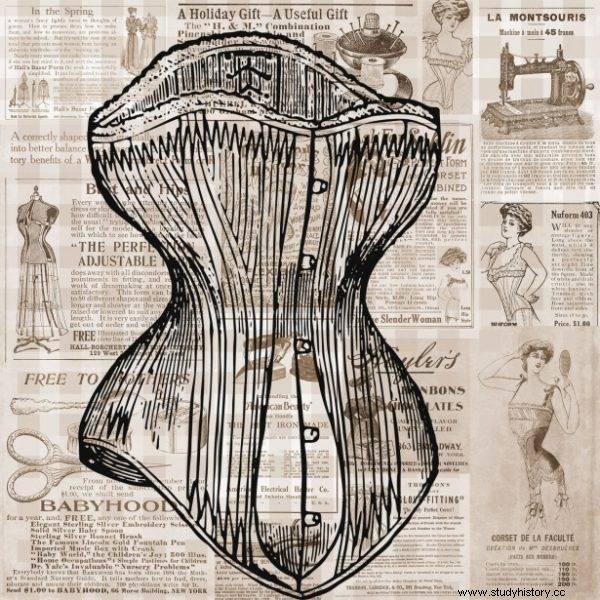What women did in front of the mirror about a hundred years ago, who wanted to meet the standards of beauty of that time, today may seem funny or even ... scary.
Some of the beautifying methods were so bizarre, and the effect of these treatments must have differed so much from today's image of attractiveness that we shake our heads when reading about them.
And yet our great-grandmothers, in their somewhat blindly following advice from women's magazines, are no different from ourselves! Here are some of the ways ladies of the late 19th and early 20th centuries resorted to to improve Nature.
1. Paint to emphasize the veins
Fashion for a tan began to slowly gain recognition from the 1920s. Previously, white reigned supreme. A very fair complexion was a sign of gender delicacy, elegance and social standing. In addition to substances that were supposed to help maintain alabaster pallor, another trick was used!
The ladies were ready for a lot of sacrifice, just to live up to the ideal. For example, grabbed a brush and, where nature stupefied them, nets of veins like on a marble bust, they helped each other with ... watercolor paints.

A woman painting her lips under a paint template at a cosmetic exhibition.
They should have been used because, thanks to dilution with water, they did not draw too clear lines - writes Aleksandra Zaprutko-Janicka in the book "Beauty without preservatives. Beauty secrets of our great-grandmothers ”. After all, nothing pleases the eye like blue veins showing through the skin!
2. Mercury for pimples
Even the innocent, charming freckles of elegant ladies from the turn of the 19th and 20th centuries seemed to be something extremely disfiguring. What to talk about pimples, blackheads, moles, warts ... Such blemishes on the white face were taken deadly seriously. Poison.
For example, in the early 1900s, it was advised to wash blemishes with mercury ointment. The problem is that mercury exfoliates the epidermis, acts as an astringent and brightens the skin, but it is also very toxic, leads a straight path to madness, poisoning and even death.
3. Arsenic for warts
Warts were dealt with equally ruthlessly. Aleksandra Zaprutko-Janicka in "Beautifully without preservatives" recalls the advice of doctor Izrael Fels, who in the book "Hygienic Cosmetics with Figures" from 1920 recommended ... a pinch of arsenic!
Indeed, the remedy might have been effective:it was enough to exaggerate a little with the mentioned arsenic and the warts became the absolute least of a problem - we read in "Beautiful without preservatives".
4. On dry skin - fat. No water!
Beauty guides from the 19th century already distinguished skin types - oily, dry or combination skin. Appropriate treatments and cosmetics were adjusted to them. Much of the old advice can still be used successfully today. But some of them would surely not be to the liking of today's girls…

Tools for the care of female beauty.
For very dry skin it was recommended to completely remove water and soap . The faces were not washed from then on, but rubbed and rubbed with various types of fat. Before going to bed, the face was copiously covered with lanolin. Oil was used for the day and it was applied with a cotton swab.
After this shock treatment, it was possible to return to washing the face, but it was recommended to use boiled water with the addition of glycerin for this. Perhaps the effects of such treatments were not the worst, but the feeling of an unwashed and eternally greasy face must have been somewhat uncomfortable.
5. A burning smell means that the great lady is getting ready for a prom
Before tomboys in their loose dresses and short, comfortable hairstyles appeared on the pages of magazines and on the streets, the elegant ladies spent long hours arranging their ankle-length strands into intricate hairstyles.
Before the First World War, the normal hairdressing procedure was to burn your hair with irons. In those days, there were no straighteners and curlers with protective coatings. There were also no products protecting the hair structure against excessive heat - Aleksandra Zaprutko-Janicka writes in her book "Beauty without preservatives".

Before tomboys in loose dresses and short hairstyles appeared on the pages of magazines and on the streets, the elegant ladies spent long hours arranging their ankle-length curls into intricate hairstyles ... often burning their hair. A tomboy on the cover of 1922's Saturday Evening Post
The strands were arranged with the help of heated devices, which must have had a terrible effect on the hair structure. Often after such treatment, the strands were left in the hands of untrained hairdressers. No wonder, then, that the ladies collected their hair after combing and stored it in boxes to use them to style damaged hairstyles.
6. Washing your head? Once a month!
Cleanliness is the basis of health and the soul of the toilet, so a lot depends on keeping your hair clean - we read in "The Guide for Ladies or Advice for the Fair Sex" from 1842. Everything seems to be correct, but the rest of the argument is more and more surprising. In order to maintain this desired purity, we do not use water and shampoo, but ... a set of combs and brushes!
For what you need to do in the morning you need to spread them well with a thin comb and be careful not to tear them off or break them. If the hair is long, it is recommended to comb it with two combs - a thin and thick one. Then we "clean" the hair with a soft bristle brush, preferably rice root.
There is also no need to overdo it - if the hair is not very long and lush, you can use a thick comb every two or three weeks. Otherwise, however, they require "cleaning" once a week. However, if you get dandruff, unfortunately you need to comb your hair every day for at least 20 minutes.

Ladies at the turn of the 19th and 20th centuries washed their hair once a month ... Painting by Leon Wyczółkowski, 1903
And what to do after the prom, when the hairstyle is polluted with dust and sweat? God forbid you must not lie down in the intricate pinning! Hair should be "spread" and wiped with a dry cloth, and in the morning - exactly like that! - brush thoroughly.
If, however, it is necessary to use water, When, by nature or due to the excessive use of pomades and Oils, the hair becomes greasy, dark and opaque , pour a little warm water (cool in summer) on the saucer, dissolve a little soap and wash your hair with a soaked sponge.
How often should you resort to water and soap so as not to deserve to be called dirty? What may seem shocking today, as part of normal hygiene, it was recommended that you wash your hair… once a month! - Aleksandra Zaprutko-Janicka writes in her book "Beauty without preservatives".
Alternatively, if someone had an oily problem, they could be washed off once a week in two different ways. For example, with mild soap and lukewarm water or egg yolk and lukewarm water.

The hairstyles of elegant ladies from the turn of the 20th century certainly did not look that good ... A drawing by Charles Gibson, circa 1900
Using cold for this was considered unhealthy. It was supposed to be extremely harmful to the hair and cause hair loss. Also, according to Dr. Hojnacki, washing too often dried them out and made them brittle.
7. For unwanted hairs - quick lime, arsenic and pumice
Hair sometimes grows in a bizarre way above the forehead, sometimes along the ears, like men's favorites, or it extends at the nape of the neck and forms a collar - writes the author of "A Guide for Ladies or Advice for the Fair Sex". But it does not leave the readers alone with this sad observation. It has a foolproof way to get rid of unwanted hairs for them!
Just take two doses of quicklime , mix with combination of realgar , that is, arsenic sulfide, boil in half a pound of alkaline lye . The resulting substance - a homemade depilatory cream - was to solve the problem of excessive hair once and for all. It is good that, at the same time, caution was advised when using this remedy. Apparently it could irritate the skin…
When the ladies started wearing shorter and shorter dresses, the hair on the legs also became a problem. Here, drastic measures were also used, although they were no longer poisonous. The ladies were rubbing their poor limbs with… pumice! After such depilation, the skin of the legs definitely needed further care treatments. And dressings…
8. A body cloaked in armor
Beauty is not only a beautiful face and hair, but also a figure. The perfect body from the turn of the century had almost as unrealistic proportions as Barbie dolls. Today, in pursuit of such a pattern, women torture themselves in gyms, suck off fat, inject it elsewhere, or even remove their ribs. Back then, the art of tailoring came to the rescue.
As the feminist Irena Krzywicka noted in her memoirs, “women from“ higher ”circles put armor on the whole body. High and long corsets that gave the figure an artificial curve - we read in "Beautiful without preservatives":
The corset reliably modeled the posture. In addition to holding the breasts and pushing them upwards, he made the waist slimmer and kept his back absolutely straight. By doing all of this, it was also wreaking havoc on the body.
You don't have to be an anatomy expert to know that when he was tied up with all his strength, he was impossibly squeezing internal organs. In this armor it was simply impossible to breathe fully.

Thanks to the book by Ola Zaprutko-Janicka entitled "Beauty without preservatives" you will learn the beauty secrets of our great-grandmothers. Buy now with a discount on empik.com.
9. Fatty diet
It's not a typo. For a nineteenth-century lady, "loss of round shapes" or, in other words, "falling off the body" was what, for today's women, "unnecessary kilograms". The waist was supposed to be thin, but the corset was responsible for that. But the breasts and shoulders pouring out of the necklines, as well as the hands and face of the lady, should be plump and rounded.
If the unfortunate lady had already "fallen from her body", the evil could have been remedied. The recipe was wonderfully simple - it was recommended not to have any problems, not to have a lot of exercise, to sleep for at least nine hours for a long time, for breakfast drink a cup of chocolate with Salepa, Persian, mixed with two yolks, in a few hours to eat a little white lamb, fatty veal or juicy beef.
It was also necessary to snack between meals - and these are potato means cooked in strong broths, groats with cream, almond milk, eggs in milk or chocolate creams. In this case, daily relaxation baths were also encouraged, followed by a meal. After eating, you had to lie down on the sofa, drink a cup of chocolate and sleep until lunch.
In the book "Beauty without preservatives" you can find recipes for a fatty diet, such as a fattening tincture with cognac, honey and olive oil. Perhaps today there will be ladies who would like to round their shapes a bit.

First, the "fat diet" and then the corset. And how not to go crazy?
There is no need, however, to go too far in, as Dr. Hojnacki describes it, fattening treatment, aging and strenuous nutrition. A hundred years ago, excessive obesity was also disapproved of - quite the contrary! If the lack of a body is not beautiful, extreme obesity becomes gross - it was written mercilessly in The Guide for Ladies.
However, too fluffy ladies were not left to themselves - and for them there were some invaluable advice. It was recommended to take long walks, digest the night without sleep, eat little, talk a lot, be able to move around constantly and learn constantly . Other recommendations included eating sugar (?) And spitting saliva frequently!
Bibliography:
- Fashionable Cosmetics. A guide for ladies , Górzno-Pomorze:"Feniks", Printing "Lech", Gniezno 1928.
- A Guide for Ladies or Advice for the Fair Sex , Print by P. Barycki, Warsaw 1842.
- Zaprutko-Janicka Aleksandra, Beauty without preservatives, Znak, Krakow 2016.
